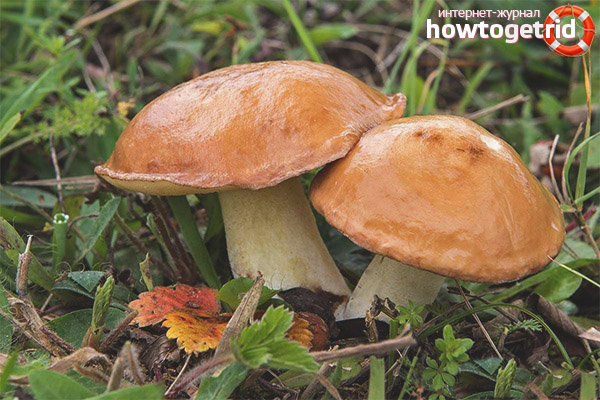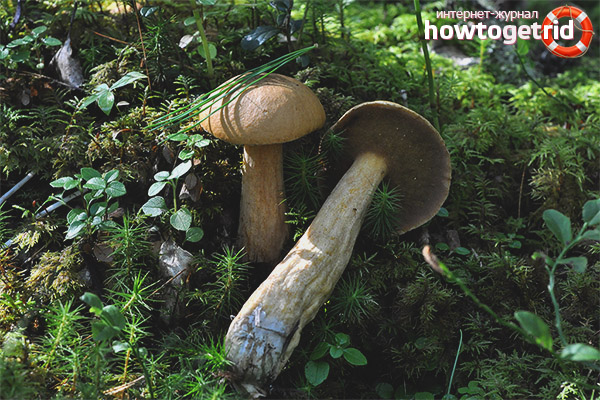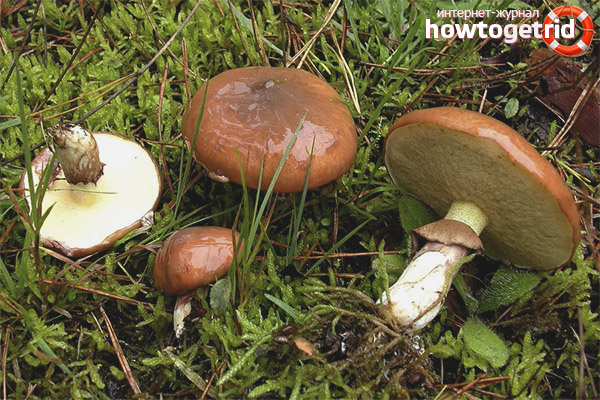The content of the article
The discussed variety of mushrooms is called a nipple due to the characteristic slippery cap. If you consider the mushroom in full detail, it may seem that its skin is oiled. It shines and shimmers. In different countries of the world this variety is not called as soon as: butter, butter, butter, etc. Today's material is dedicated to this variety. We will consider it in detail.
Description
- The leg in the cylinder format does not grow in height more than 10 cm. The average values are kept within 5-8 cm. The diameter of the base is 3-4 cm. It is painted with a whitish hue, the lower part is darker, the tone matches the top. There are frequent cases when a white liquid comes out of the leg. It freezes, the mushroom looks grainy.
- Oil mushrooms belong to the middle representatives of the mushroom family. They are somewhat similar to mossovics. The hat in the format of the hemisphere after ripening of the mushrooms becomes flat. According to its external data, it resembles a pillow. In diameter it grows up to 15 cm. The final shade of the fungus depends on the territory of growth and the variety of a particular specimen.
- A distinctive characteristic is that there is a skin-film on the hat, it glistens and sticks. When it's damp outside, the hat becomes slippery. If the mushrooms grow dry, the hat will crack or become velvet. The peel is easily detachable from the cap. The color of the hat varies, it may be buffy, brownish, brown, yellow, chocolate. Specks or color transitions may be observed.
- The soft part is densified, soft, pigmented in yellow or white. If you cut it or break it, a red or blue pigment will appear. The pulp has no smell, but sometimes the fungus may smell like needles. Lubricants are edible only in the first week of maturation, because they age quickly. After 8 days, the skin sags and darkens, the fruiting bodies begin to rot and worm.
- Not everyone is oily, but more of them have a bract. It is located under the hat, connecting it to the base. When a specimen matures, its cover is torn. A ring forms on the leg. With regard to reproduction, it is carried out by spores of yellow color or so.
Growth
- Representatives of the species are common in Asian, European countries. They are found in the Northern Hemisphere. However, there are colonies growing in Australia and Africa. Oilfishes prefer to live under needles, but are often found in an oak grove or next to birches.
- It all depends on the particular colony. The first group can grow with only one species of tree. The second lives with different varieties, including cedar, spruce, pine, deciduous species. These mushrooms practically do not grow in the dark forest.
- If an ambulance is planned for quiet hunting, then it is necessary to go to deforestation, edges, forest paths and roadsides, as well as various clearings and thickets of young needles. The butterflies grow singly and colonially.
- These representatives of the species appear early enough, so in June-July you can engage in gathering. It lasts until October, but it all depends on the territory of growth. In some climatic zones, these mushrooms go in April.
- If you follow the national signs, then the first batch of mushrooms butter coincides with the beginning of flowering pines. And the second crop makes itself felt as soon as the linden begins to bloom in July. The third approach is not connected with anything, just for mushrooms all the conditions for a comfortable existence are created. They need to go in the middle or end of autumn.Because at this time, the temperature usually keeps above 15 degrees.
- These mushrooms do not grow well at low temperatures. They need warmth as well as sufficient humidity. After the rain, the first specimens appear on the surface after two days. If the soil freezes in the autumn season, then the mushrooms will stop growing.
Varieties of Oiler
Now we will study what varieties of these mushrooms exist, how they differ among themselves, and how they look. It will be exclusively about edible species.
- This variety is edible, it occurs quite early in the summer season. Growth is carried out by colonies, so collecting a basket is not difficult. The hat grows up to 5–9 cm in diameter, the format changes as it grows, as does the color. Young growth is famous for a convex hat, it is pigmented by a redhead. In older specimens, the tip resembles a pillow; it is painted orange-yellow.
- The surface of the hat is glossy, dry and lint-free. However, when the street is damp, the skin becomes covered with mucus and becomes slippery. Separating the skin is not difficult. The base has a brownish, brown or light yellow color. The length of the leg grows to 8 cm. With a diameter of 1.5 cm. Maximum. Cylinder format.
- From the pores oozing liquid, which is usually located in the upper part of the base. It dries up, after which the fungus itself appears spotty and uneven. There are no rings on the base, the tubes grow to the pedicle, are pigmented in yellow or yellow-brown.
- The soft part is painted in a light beige-yellow color. It smells good, tastes like nuts. If you cut the fungus, in this area it will darken. Reproduction is carried out by spores, the powder has a brownish-yellow color. Butterflies grow under a pine or spruce. You can meet them in the thickets, starting in June and ending in November.
White
- Otherwise, this variety is called pale or soft. It grows in groups, it is necessary to search in the same way as the previous variety. Between the beginning of summer and the middle or beginning of November. White representatives settle under a cedar or pine. The hat is changing, it all depends on age. She first sticks out, then becomes flat or takes the form of a funnel.
- The apex is about 10 cm in size. The skin on it is slippery, smooth, pigmented with a yellowish tinge. A purple glow may appear periodically. Tubes are stained dark. Leg in cylinder format, grows up to 7 cm. Maximum. It is painted in yellow or white, brown spots may be observed. The ring is missing.
- If you remove the skin, then the soft part will be pigmented with a purple tint. In the middle, it will turn yellow or whiten. Taste and smell are practically absent. When collecting, preference is given to young growth, because old specimens rot and become worms.
Motley
- In another way, this variety is called a brown-yellow oiler, pestle, bog moss, swamp, sand moss. The hat grows up to 13 cm in diameter. In young animals, it is hemisphere, and in adult specimens it is fleshy, like a pillow. In shade, the top is olive, brown-yellow, reddish or orange. It’s difficult to peel off the skin.
- If we compare this representative of the family with self-similar, the distinguishing characteristic is the absence of mucus on the hat. There are small villi. The length of the base is 4-9 cm, the format of the cylinder or pins, the diameter is 2 cm.
- The soft part takes on a bluish tint on the cut. The tubes are painted olive. The mushroom smells like metal or needles. These fungi grow in small colonies, so you will have to work hard when collecting.
Ordinary
- Such fruiting bodies are also called second name. Most often, mushrooms are called real, late, autumn or yellow.In such specimens, the hat has a convex shape, while the color may be brown-chocolate, red-brown, brown-purple or yellow-brown. There is also a mucous membrane.
- When processing it is quite easy to remove. The diameter of the cap can reach up to 13 cm. You can also notice that the tubes are attached to the leg. They have a pleasant yellowish tint. Spores are brown. The leg of the fruits in height can be up to 10 cm, and its diameter is up to 3 cm.
Red-haired
- At such fruiting bodies one can observe a fleshy hat. Its diameter can reach up to 15 cm. They have a semicircular shape. Over time, the hat becomes pillow-shaped. It is painted in yellow-orange color. In this case, a fibrous structure with reddish scales can be observed.
- At the edges of the hat visible remains of a white bedspread. It connects the leg and the cap of young fruiting bodies. When the cover is torn, a ring can be seen on the leg. Its height can reach 11 cm. The color is almost the same as that of the hat.
- The pulp has a dense structure. It is painted yellow. Moreover, if the pulp is cut, it will turn red. The tubular layer has an orange tint. Spore powder is olive green. The bodies begin to bear fruit from mid-summer to mid-autumn on the mountain slopes and in coniferous forests.
- Edible mushroom has a brown hat, the diameter of which can reach up to 15 cm. It does not have an adhesive surface. Rather, the surface is more matte. You can even say as if it is covered with wax. In this case, the hat may be yellow or brownish.
- Often the flesh is yellowish. If you cut it, you can see a bluish color. It tastes slightly sour. Tubes are often painted from olive to brown. You can also observe an interesting picture of how the pores of the fungus secrete whitish juice.
- After drying, it becomes brown. The leg of the fetus in question has a thickness of up to 3 cm, and a height of up to 12 cm. At the same time, it narrows closer to the cap. The surface of the legs of such fungi may have reddish blotches.
Siberian
- Presented fruiting bodies are edible fungi, but only in the lower category. Moreover, their sizes are average. The hat can have a maximum diameter of 10 cm. In young specimens, it is spherical in shape. Over time, she straightens.
- In young fruits, the hat is colored straw. With age, it begins to darken. Red-brown spots appear. The skin of such mushrooms with mucus. Especially after the rain. However, it is very easy to remove.
- Young fruiting bodies have a veil; over time, it breaks. As a result, the ring remains on the leg. Yellow tubes acquire a brownish color over time. Sometimes a small amount of fluid is released. Which, after drying, darkens.
- The stalk of such fruits grows up to 9 cm. Thickness can be about 3 cm. Basically, such mushrooms are found in Siberia and North America. They are rarely seen in Europe. Often the fruits grow in coniferous forests. Such mushrooms are quite rare.
Notable
- The hat has a rather large size up to 15 cm and a dense, fleshy pulp. Leg relatively short. On the surface of the cap there is sticky mucus and flakes. When processing, peeling is not a problem.
- The length of the leg varies from 4 to 11 cm. The thickness does not exceed 2 cm. There is also a ring on it. The leg is painted in a whitish-yellow hue. The flesh is yellow, and when cut, it turns pinkish. After that, it turns brown.
Benefit
- Fruit bodies have low calorie content, an unforgettable taste and many beneficial qualities. On 100 gr. raw materials account for only 20 Kcal. They contain B vitamins, retinol, ascorbic and nicotinic acid.
- The pulp of mushrooms is also saturated with zinc, potassium, manganese, phosphorus and iron. Oil mushrooms act as a natural antibiotic, aphrodisiac and immunostimulant.
- Also, the systematic consumption of fruiting bodies helps eliminate severe migraines. Mushrooms are successfully used in the treatment of the musculoskeletal system, nervous system and heart.
Contraindications
- If you incorrectly prepare fruiting bodies, then you may encounter problems of a certain nature. Remember that you need to collect copies in environmentally friendly places. Otherwise, you can earn poisoning.
- The spongy structure of the fungi easily absorbs all the harmful compounds that are present in the soil and the environment. Mushrooms are able to accumulate heavy metals in themselves. Especially you should be wary of old mushrooms with large hats.
- In no case do not collect and do not eat wormy specimens. Waste from the life of worms can provoke severe poisoning and an allergic reaction in humans.
- Before cooking, always get rid of the film on the mushrooms, which is present on the hats. The problem is that even with heat treatment it often provokes diarrhea. Of particular danger are canned mushrooms with the presence of such a film. In addition, instances must be thoroughly washed.
In this article, we examined healthy and delicious mushrooms that have many edible varieties. Remember that gathering must be done, taking into account the place of growth and climatic conditions. Most of the specimens appear in the summer, fruiting is carried out until the fall. Mushrooms do not like dark forests, so you need to look for them in bright areas.
Video: oiler (Suillus)













Submit